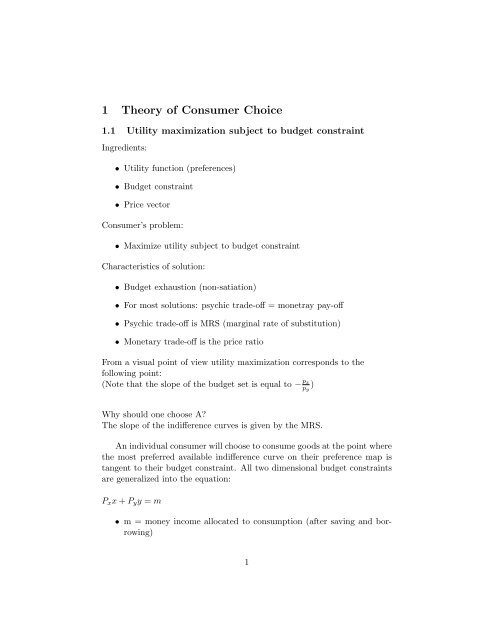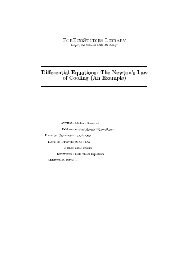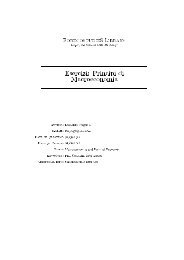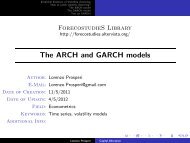Consumer Theory.pdf - ForEcoStudies
Consumer Theory.pdf - ForEcoStudies
Consumer Theory.pdf - ForEcoStudies
- No tags were found...
Create successful ePaper yourself
Turn your PDF publications into a flip-book with our unique Google optimized e-Paper software.
1 <strong>Theory</strong> of <strong>Consumer</strong> Choice1.1 Utility maximization subject to budget constraintIngredients:• Utility function (preferences)• Budget constraint• Price vector<strong>Consumer</strong>’s problem:• Maximize utility subject to budget constraintCharacteristics of solution:• Budget exhaustion (non-satiation)• For most solutions: psychic trade-off = monetray pay-off• Psychic trade-off is MRS (marginal rate of substitution)• Monetary trade-off is the price ratioFrom a visual point of view utility maximization corresponds to thefollowing point:(Note that the slope of the budget set is equal to − pxp y)Why should one choose A?The slope of the indifference curves is given by the MRS.An individual consumer will choose to consume goods at the point wherethe most preferred available indifference curve on their preference map istangent to their budget constraint. All two dimensional budget constraintsare generalized into the equation:P x x + P y y = m• m = money income allocated to consumption (after saving and borrowing)1
• P x = the price of a specific good• P y = the price of all other goods• x = amount purchased of a specific good• y = amount purchased of all other goodsThe equation can be rearraged to represent the shape of the curve on agraph:y = (m/P y ) − (P x /P y )x, where (m/P y ) is the y-intercept and (−P x /P y )is the slope, representing a downward sloping budget line.The factors that can shift the budget line are a change in income (m),a change in the price of a specific good (P x ), or a change in the price of allother goods (P y ).2
1.2 Interior and corner solutionsThere are two types of solution to this problem:1. Interior solution2. Corner solutionThe one below is an example of a corner solution. In this specific examplethe shape of the indifference curves means that the consumer is indifferentto the consumption of good y. Utility increases only with consumption ofx.In the graph above preference for y is sufficiently strong relative to xthat the the psychic trade-off is always lower than the monetary trade-off.3
1.3 Mathematical solution to the <strong>Consumer</strong>’s ProblemHow do we know a solution exists for consumer? How do we know theconsumer can choose?Mathematics:Max } {{ } U(x, y) (1)(x,y)s.t p x x + p y y ≤ I (2)L = U(x, y) + λ(I − p x x − p y y) (3)∂L∂x = U x − λp x = 0 (4)∂L∂y = U y − λp y = 0 (5)∂L∂λ = I − p xx − p y y = 0 (6)Rearraging the first (4) and second (5) F.O.Cs: 1U xU y= p xp y(7)1 From U x − λp x = 0 we obtain that U x = λp x. This implies that Uxp x= λ. Thesame algebra can be used for equation U y − λp y = 0, thus Uy= λ. To conclude we get:U xp x= Uyp y= λ.p y4
∂L∂I = λ (14)λ equals the shadow price of the budget constraint, i.e. it expresses thequantity of utils that could be obtained with the next dollar of consumtpion.This shadow price is not uniquely defined. It is defined only up to a monotonictransformation.What does the shadow price mean? It’s essentially the utility value of relaxingthe budget constraint by one unit (e.g., one dollar).We could also have determined that ∂L/∂I = λ without calculations byapplying the envelope theorem. At the utility maximization solution to thisproblem, x ∗ and y ∗ are already optimized and so an infinitesimal change inI does not alter these choices. Hence, the effect of I and U depends only onits direct effect on the budget constraint and does not depend on its indirecteffect (due to re-optimization) on the choices of x and y. This enveloperesult is only true in a small neighborood around to the original problem.6
Corner Solution: unusual caseWhen at corner solution, consumer buys zero of some good and spendsthe entire budget on the rest.What problem does this create for the Lagrangian ? The problem is thata point of tangency doens.t exist for positive values of y. Hence we alsoneed to impose .non-negativity constraints.: x ≥ 0, y ≥ 0. This will not beimportant for problems in this class, but it’s easy to add these constraintsto the maximization problem.1.5 An Example ProblemConsider the following example problem:U(x, y) = 1 4 lnx + 3 4 lnyNotice that this utility function satisfies all axioms:1. Completeness, transitivity and continuity2. Non-satiation: U x = 14x > 0 for all x > 0. U y = 34y> 0 for all y > 0.In other words, utility rises continually with greater consumption ofeither good, though the rate at which it rises declines (diminishingmarginal utility of consumption).3. Diminishing marginal rate of substitution:Along an indifference curve of this utility function: Ü = 1 4 lnx 0+ 3 4 lny 0.Totally differentiate:0 = 14x 0dx + 34y 0dy.7
Which provides the marginal rate of substitution − dy ∣∣Üdx= UxU y= 4y 012x 0.The marginal rate of substitution of y for x is increasing in the amountof y consumed and decreasing in the amount of x consumed; holdingutility constant, the more y the consumer has, the more y he wouldgive up for one additional unit of x.Numerical Examplep x = 1p y = 2I = 12Write the Lagrangian for this utility function given prices and income:Max } {{ }(x,y)U(x, y)s.t p x x + p y y ≤ IThe Lagrangian function:L = 1 4 lnx + 3 4lny + λ(12 − 1x − 2y)1. ∂L∂x = 14x − λ = 02. ∂L∂y = 34y − 2λ = 03. ∂L∂λ= 12 − x − 2y = 0From the general solution of the problem we know that:U xU y= pxp yand according to our numerical example we obtain:1/4x3/4y = 1 2 . 8
The interpretation of this expression is that the MRS (psychic trade-off)is equal to the market trade-off (price-ratio).What is ∂L∂I ?As pointed out before, this is equal to λ. Thus:λ = Uxp x= Uyp y= 14x ∗ = 38y ∗ .The next dollar of income could buy one additional x, which has marginalutility 14xor it could by 1 ∗ 2 additional y′ s, which provide marginal utility 34y ∗(so the marginal utility increment is 1 2 · 34y). It’s important that ∂L/∂I = λ∗is defined in terms of the optimally chosen x ∗ , y ∗ . Unless we are at theseoptima, the envolope theorem ( does not apply. ) ( So, ∂L/∂I would ) also depend∂xon the cross-partial terms U x ∂I − λp x ∂x∂y∂I+ U y ∂I − λp y ∂y∂I.9
Contents1 <strong>Theory</strong> of <strong>Consumer</strong> Choice 11.1 Utility maximization subject to budget constraint . . . . . . . 11.2 Interior and corner solutions . . . . . . . . . . . . . . . . . . . 21.3 Mathematical solution to the <strong>Consumer</strong>’s Problem . . . . . . 41.4 Interpretation of λ, the Lagrangian multiplier . . . . . . . . . 51.5 An Example Problem . . . . . . . . . . . . . . . . . . . . . . 710







